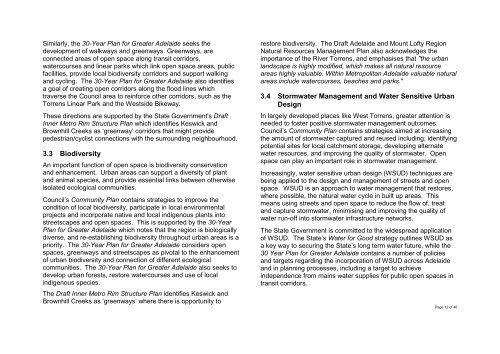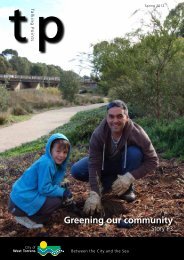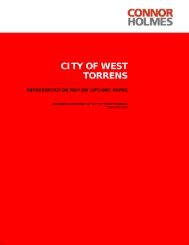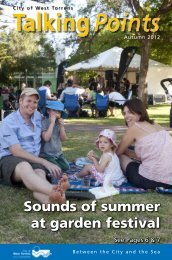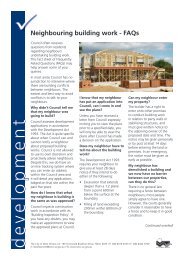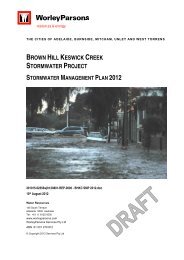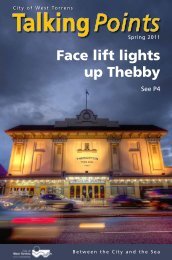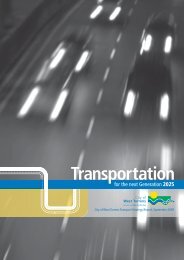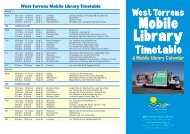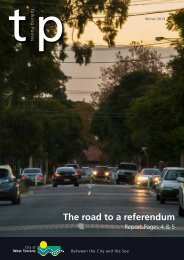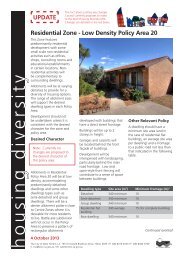Open Space and Public Place Plan - City of West Torrens - SA.Gov.au
Open Space and Public Place Plan - City of West Torrens - SA.Gov.au
Open Space and Public Place Plan - City of West Torrens - SA.Gov.au
Create successful ePaper yourself
Turn your PDF publications into a flip-book with our unique Google optimized e-Paper software.
Similarly, the 30-Year <strong>Plan</strong> for Greater Adelaide seeks the<br />
development <strong>of</strong> walkways <strong>and</strong> greenways. Greenways, are<br />
connected areas <strong>of</strong> open space along transit corridors,<br />
watercourses <strong>and</strong> linear parks which link open space areas, public<br />
facilities, provide local biodiversity corridors <strong>and</strong> support walking<br />
<strong>and</strong> cycling. The 30-Year <strong>Plan</strong> for Greater Adelaide also identifies<br />
a goal <strong>of</strong> creating open corridors along the flood lines which<br />
traverse the Council area to reinforce other corridors, such as the<br />
<strong>Torrens</strong> Linear Park <strong>and</strong> the <strong>West</strong>side Bikeway.<br />
These directions are supported by the State <strong>Gov</strong>ernment's Draft<br />
Inner Metro Rim Structure <strong>Plan</strong> which identifies Keswick <strong>and</strong><br />
Brownhill Creeks as ‘greenway’ corridors that might provide<br />
pedestrian/cyclist connections with the surrounding neighbourhood.<br />
3.3 Biodiversity<br />
An important function <strong>of</strong> open space is biodiversity conservation<br />
<strong>and</strong> enhancement. Urban areas can support a diversity <strong>of</strong> plant<br />
<strong>and</strong> animal species, <strong>and</strong> provide essential links between otherwise<br />
isolated ecological communities.<br />
Council’s Community <strong>Plan</strong> contains strategies to improve the<br />
condition <strong>of</strong> local biodiversity, participate in local environmental<br />
projects <strong>and</strong> incorporate native <strong>and</strong> local indigenous plants into<br />
streetscapes <strong>and</strong> open spaces. This is supported by the 30-Year<br />
<strong>Plan</strong> for Greater Adelaide which notes that the region is biologically<br />
diverse, <strong>and</strong> re-establishing biodiversity throughout urban areas is a<br />
priority. The 30-Year <strong>Plan</strong> for Greater Adelaide considers open<br />
spaces, greenways <strong>and</strong> streetscapes as pivotal to the enhancement<br />
<strong>of</strong> urban biodiversity <strong>and</strong> connection <strong>of</strong> different ecological<br />
communities. The 30-Year <strong>Plan</strong> for Greater Adelaide also seeks to<br />
develop urban forests, restore watercourses <strong>and</strong> use <strong>of</strong> local<br />
indigenous species.<br />
The Draft Inner Metro Rim Structure <strong>Plan</strong> identifies Keswick <strong>and</strong><br />
Brownhill Creeks as ‘greenways’ where there is opportunity to<br />
restore biodiversity. The Draft Adelaide <strong>and</strong> Mount L<strong>of</strong>ty Region<br />
Natural Resources Management <strong>Plan</strong> also acknowledges the<br />
importance <strong>of</strong> the River <strong>Torrens</strong>, <strong>and</strong> emphasises that "the urban<br />
l<strong>and</strong>scape is highly modified, which makes all natural resource<br />
areas highly valuable. Within Metropolitan Adelaide valuable natural<br />
areas include watercourses, beaches <strong>and</strong> parks."<br />
3.4 Stormwater Management <strong>and</strong> Water Sensitive Urban<br />
Design<br />
In largely developed places like <strong>West</strong> <strong>Torrens</strong>, greater attention is<br />
needed to foster positive stormwater management outcomes.<br />
Council’s Community <strong>Plan</strong> contains strategies aimed at increasing<br />
the amount <strong>of</strong> stormwater captured <strong>and</strong> reused including; identifying<br />
potential sites for local catchment storage, developing alternate<br />
water resources, <strong>and</strong> improving the quality <strong>of</strong> stormwater. <strong>Open</strong><br />
space can play an important role in stormwater management.<br />
Increasingly, water sensitive urban design (WSUD) techniques are<br />
being applied to the design <strong>and</strong> management <strong>of</strong> streets <strong>and</strong> open<br />
space. WSUD is an approach to water management that restores,<br />
where possible, the natural water cycle in built up areas. This<br />
means using streets <strong>and</strong> open space to reduce the flow <strong>of</strong>, treat<br />
<strong>and</strong> capture stormwater, minimising <strong>and</strong> improving the quality <strong>of</strong><br />
water run-<strong>of</strong>f into stormwater infrastructure networks.<br />
The State <strong>Gov</strong>ernment is committed to the widespread application<br />
<strong>of</strong> WSUD. The State’s Water for Good strategy outlines WSUD as<br />
a key way to securing the State’s long term water future, while the<br />
30 Year <strong>Plan</strong> for Greater Adelaide contains a number <strong>of</strong> policies<br />
<strong>and</strong> targets regarding the incorporation <strong>of</strong> WSUD across Adelaide<br />
<strong>and</strong> in planning processes, including a target to achieve<br />
independence from mains water supplies for public open spaces in<br />
transit corridors.<br />
Page 12 <strong>of</strong> 46


